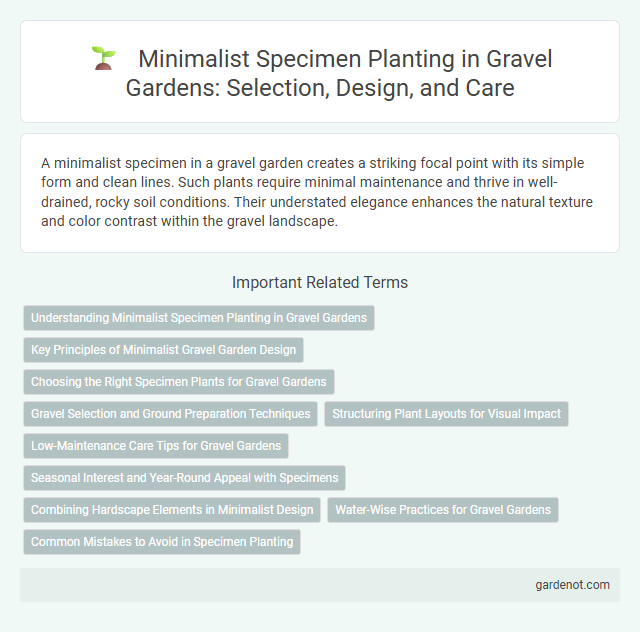A minimalist specimen in a gravel garden creates a striking focal point with its simple form and clean lines. Such plants require minimal maintenance and thrive in well-drained, rocky soil conditions. Their understated elegance enhances the natural texture and color contrast within the gravel landscape.
Understanding Minimalist Specimen Planting in Gravel Gardens
Minimalist specimen planting in gravel gardens emphasizes selecting a single, architecturally striking plant species to create a focal point within the landscape. This approach relies on plants with strong structural qualities, such as agave, yucca, or ornamental grasses, that thrive in well-drained, gravelly soils. Proper understanding of plant growth habits, drought tolerance, and spatial requirements ensures longevity and visual impact in minimalist gravel garden designs.
Key Principles of Minimalist Gravel Garden Design
Minimalist gravel garden design emphasizes simplicity, clean lines, and a restrained plant palette to create a tranquil outdoor space. Key principles include the use of monochromatic gravel or stones, strategic placement of one or two specimen plants, and the incorporation of natural textures to enhance visual interest without clutter. This approach maximizes functionality while maintaining aesthetic harmony and low maintenance requirements.
Choosing the Right Specimen Plants for Gravel Gardens
Selecting the right specimen plants for a gravel garden involves prioritizing drought-tolerant, low-maintenance species such as lavender, ornamental grasses, and succulents which thrive in well-drained, nutrient-poor soil. Opt for plants with architectural forms or vibrant foliage to create strong visual focal points within the minimalist landscape. Incorporating native perennials like sedum and thyme enhances sustainability while providing seasonal interest and supporting local pollinators.
Gravel Selection and Ground Preparation Techniques
Selecting angular, crushed gravel enhances drainage and stability in minimalist gravel gardens, promoting healthy plant growth while maintaining aesthetic simplicity. Proper ground preparation involves thorough weed removal, installing a durable landscape fabric, and compacting the subsoil to prevent settling and ensure long-lasting structure. Consistent layering with graded gravel sizes facilitates water permeability and reduces soil erosion, crucial for minimal maintenance and longevity.
Structuring Plant Layouts for Visual Impact
Minimalist specimen plants in gravel gardens emphasize clean lines and bold forms, creating a striking focal point with limited species variety. Careful structuring of plant layouts enhances visual impact by using contrasting textures and repetitive spacing to guide the eye across the landscape. Strategic placement of drought-tolerant, sculptural plants like agave or yucca maximizes both simplicity and aesthetic appeal.
Low-Maintenance Care Tips for Gravel Gardens
Minimalist specimens in gravel gardens, such as sedums and lavender, thrive with low-maintenance care by requiring well-drained soil and occasional watering during dry spells. Using drought-tolerant plants reduces the need for frequent irrigation and ensures durability in various climates. Regularly removing weeds and applying a thin layer of gravel mulch helps maintain soil moisture and prevents weed growth, enhancing the garden's clean, minimalist aesthetic.
Seasonal Interest and Year-Round Appeal with Specimens
Select minimalist specimens like lavender, sedum, and ornamental grasses for gravel gardens to maximize seasonal interest and year-round appeal. These drought-tolerant plants thrive in well-drained soil, offering vibrant spring blooms, lush summer foliage, and striking winter textures. Incorporating evergreen varieties and late-season flowering perennials ensures continuous visual impact throughout the year.
Combining Hardscape Elements in Minimalist Design
Integrating minimalist specimen plants with carefully selected hardscape elements like gravel, stone pavers, and metal edging creates a harmonious gravel garden that emphasizes texture and form. The use of clean lines and neutral tones in hardscape materials enhances the sculptural quality of sparse plantings, promoting a serene and uncluttered outdoor space. Strategic placement of minimalist specimens ensures balance and visual interest while maintaining the simplicity characteristic of minimalist design.
Water-Wise Practices for Gravel Gardens
Minimalist specimens such as lavender, sedum, and ornamental grasses thrive in gravel gardens due to their low water requirements and drought tolerance. Employing water-wise practices like drip irrigation and mulching enhances moisture retention and reduces water waste in these landscapes. Selecting native, drought-resistant plants further optimizes water efficiency and ensures sustainable gravel garden maintenance.
Common Mistakes to Avoid in Specimen Planting
Common mistakes to avoid in minimalist specimen planting within gravel gardens include overcrowding plants, which hinders their natural form and growth. Selecting species unsuited to the site's soil drainage or sunlight can lead to poor health and reduced visual impact. Ensuring adequate spacing and choosing drought-tolerant, sculptural plants like agave or yucca enhances the garden's clean, modern aesthetic.
Minimalist specimen Infographic

 gardenot.com
gardenot.com